Analysis of the Jack and Daxter trilogy Translated with ChatGPT
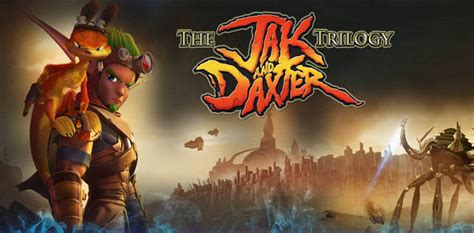
Resume
Summary:
Analysis of the Jack and Daxter trilogy on PS2.
Introduction
Ah, the Jack and Daxter trilogy! Along with Ratchet and Clank, they were my favorite games when I was a child. For years, I replayed them over and over. During that time, only masterpieces like Kingdom Hearts 2 or the desire to replay Spyro convinced me to temporarily stray from them.
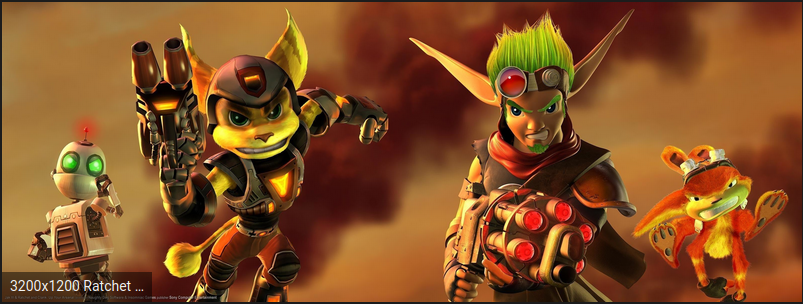
A love that has not withered with time. Well, almost. One fine day in May, a strange machine called a 'personal computer' arrived in my home, with the bonus of unlimited internet access. A whole new world then opened up to me. A world composed of an abundance of games I would never have imagined.
And gradually, without realizing it, I started to neglect my console and my cozy bed under the pretext of: 'just one last round of Civilization 4 and then I'll go to bed (the best of the Civilizations in my eyes)'. Then the move from the family home to a very cramped student accommodation definitively severed the tenuous link that remained between me and my dear PS2.
Nevertheless, for some unknown reason, I wanted to play Jack and Daxter again. This desire resulted in the writing of this review where I will attempt, with my limited skills, to make a not at all objective analysis, but hopefully well-argued, of these games that I loved so much. For your information, the images and screenshots illustrating this article have notWere made by me, but come from streams of unknown sources or images uploaded by the game's publisher for its promotion. It would have been more respectful of copyright to make my own screenshots, but it would have taken too much time and the result would not have been of such good quality.
Jack and Daxter the Precursor's Legacy
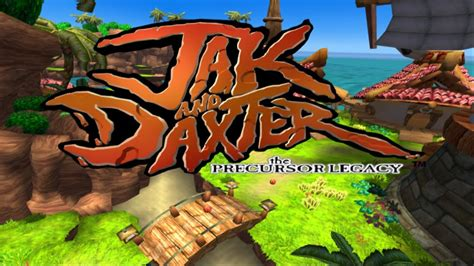
The first thing that struck me when I launched Jack and Daxter in 2024 was its intro music.
To be honest, I wondered if there was a problem with my emulator, as the music seemed strange, ugly, and especially completely different from the memories I had of it. But no, it's the real intro music of the game, which is also the music of the first level.
This surprised me all the more because in my memories, the music was one of the strong points of the game. One of the few points where I found the Jack and Daxter series superior to that of Ratchet and Clank. In retrospect, I think my surprise comes from the fact that this relaxing music with tribal tones thanks to its drums is the opposite of the atmosphere that the following games in the franchise will set (we will come back to this more during the analysis of Jack 2).
Aside from that, I have nothing particular to say about the menu, which is standard, functional, and rather nice with its view of the house of Samos. So it's time to start the actual game.
As in most games since the PS1, we are greeted by a cutscene whose graphic style has clearly aged (but is still pretty), telling us the story of this Jack and Daxter. A story that fits on a post-it: Jack and Daxter, two young adventurers, decide to go to Misty Island even though it's forbidden, as it is inhabited by a hostile race called the Lurkers who resemble animals (briefly they are orcas witha gorilla-like appearance). He sneaks in discreetly and secretly attends a Lurkers meeting where he listens to a man and a woman who clearly have the appearance of villains with mysterious powers talking about using the black echo and changing the world.
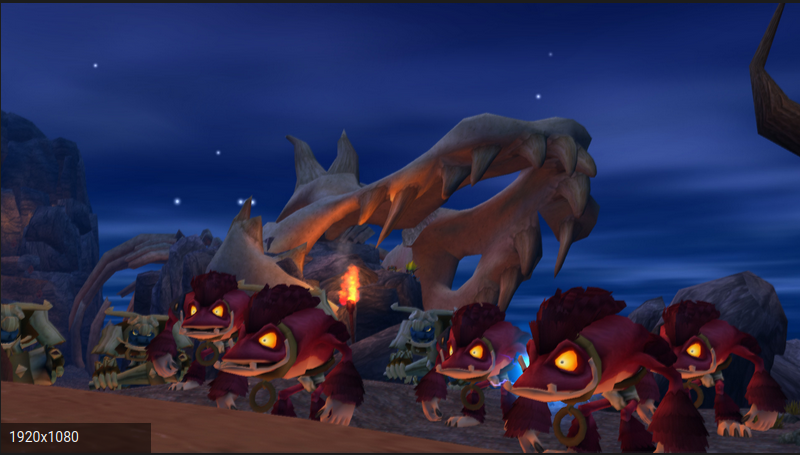
Once the meeting is over, our friends approach to examine a silo containing the mysterious substance known as dark eco and due to an accident, Daxter falls into it and is transformed into an ottsel (a mix between a weasel and an otter).
After one of the funniest sequences ever made on PS2 (and which, even as an adult knowing it by heart, made me smile), they urgently return to seek the help of the green sage Samos, who tells them he cannot help, but that far to the north, beyond the mountains, there is a sage who has spent his life studying the dark echo and may have a solution. However, for some mysterious reason, the teleporters leading there have been cut off and a lava flow has blocked the path. But Keira, the village mechanic and Samos's daughter, says that if you collect enough power cells (relics of an ancient and technologically advanced civilization that will serve as collectibles in this game), she can build you a vehicle to fly over the lava.
From there, the cinematic ends and the game begins. Well, almost, because you'll first have to go through a very boring and poorly designed tutorial.
Why poorly done? Because in addition to being overly forced and interrupting the game just when you thought you could finally play, this tutorial spends ages explaining extremely simple movements like pressing X to jump.
Honestly, why do most developers feel compelled to give us a tutorial to teach us how to jump since the PS2? The first platform games (like Mario, Sonic, or Spyro) did very well without such a tutorial for the simple reason that the first thing any normally constituted person will do when starting a game is press all the buttons and thus discover for themselves that you can jump with X.
Damn, the previous games from the studio like Crash Bandicoot didn't need to teach us how to jump. They didn't even need tutorials, or if they did, they were hidden by the first levels, cleverly designed to naturally teach us the rules of the game.
And, alongside that, this tutorial will not teach you certain movements that are essential for obtaining some energy stacks and are otherwise more complex and less intuitive, like the jump punch that will be necessary on the beach level to raise the pillars and use them as a platform.
As long as you're making such a long and mandatory tutorial, it might as well be complete. Or better yet, get rid of this stupid tutorial and give me optional help at the first places where we need those moves. The worst part is that the game does this at certain times, like when we have to use a vehicle or character for the first time. We'll see the controls appear discreetly at the bottom, and then if we hesitate, after a while, Daxter will tell us what to do.
But well, this annoying moment eventually comes to an end and the game finally begins and that's when it hits.
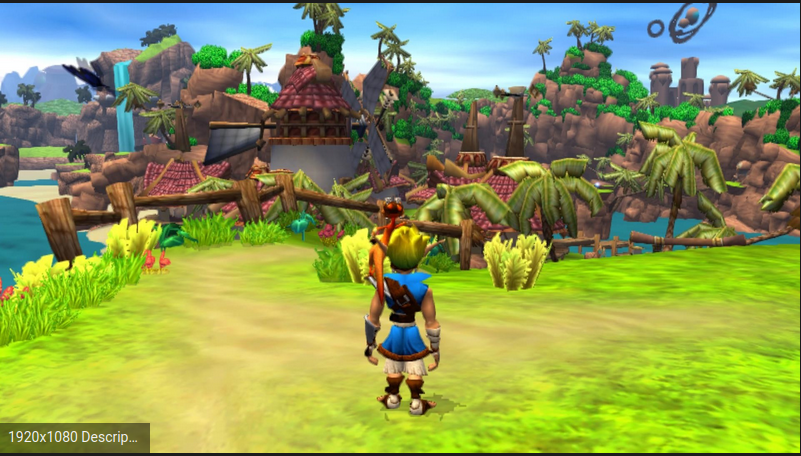
We find ourselves in a vast, colorful, and still magnificent world in 2024, where we can go wherever we want right from the start. Finally, several hours of gameplay later, we realize that apart from visiting the village that serves as the central hub at the beginning of the game, our options were actually limited to going to the beach or exploring the jungle and its abandoned precursor temple. However, when we start the game, we don't notice anything and really feel like we have a huge open world with no loading times.
An impossible feat at the time and one that continues to make its little effect in 2024. But, it's just an illusion (which works very well until the end of the game). In reality, the game consists of 3 hubs + the final level connected by teleporters (which are activated as the game progresses). Each hub provides access to 3 platform levels, each designated as corridors, plus a vehicle level to go to the next hub and activate its teleporter.
In any case, it results in a very appreciable feeling of freedom, which is reinforced by other design choices, such as not needing to have all the energy cells to finish the game. A design choice that allows less skilled players (such as children) to temporarily switch to an easier challenge, or even completely ignore the more difficult cells (or the scary levels like spider caves).
We therefore have an adaptive difficulty that will reward and stimulate the most skilled players with a very satisfying 100% completion and an additional cutscene at the end, without penalizing weaker players.
The principle is not new and is already present in Mario 64, but at the time (and even still today) it was not such a widespread choice. Indeed,Many games of the time, like Rayman, required you to finish the game 100% to see the last level.
But, since we are talking about difficulty, it is time to talk about the reputation for hard games in this series.
In the case of Jack2, this reputation is totally justified as I struggled with it (even as an adult). But, in the case of Jack 1 and 3, in my opinion, this is not the case at all. I finished these two games when I was a child without much difficulty, and once an adult, I had no difficulty repeating the feat. However, 100% in Jack and Daxter the Precursor Legacy is another matter, but it remains a perfectly acceptable challenge.
It should be noted, however, that the hidden energy cell in the mountain pass glider level is particularly tricky to obtain. It is placed prominently so that we can see it is there as we pass through the pass. However, we cannot access it until we have unlocked the yellow echo generators located in the next world. It would be a perfect design if there were something to indicate that the cell is currently inaccessible. But as it stands, everything suggests there is a way to reach it (which is not the case). Most players will therefore persist for I don't know how long, trying to find a way to access it before giving up without realizing that it is impossible.
Apart from this small hiccup, the rest of the levels are perfect and each energy stack is a pleasure to seek out. Not to mention the great choreography and music that accompany each of our discoveries.
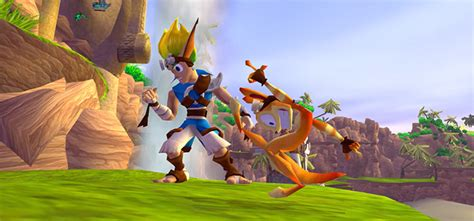
By the way, let's talk about the music again. I said it, I didn't like the music at the beginning. I am well aware that it's a matter of taste, but I didn't like it. However, very quickly, you forget about it because it is quite discreet and it fits the atmosphere of the place well. And the following music pleased me much more. Notably, the final battle music. So, despite a bad first impression, I must admit that even if they are not as good as I remember, the music of Jack 1 is of very good quality.
For the rest, it is a fairly classic platform game, but very well executed, which stands out for its extremely beautiful and colorful open world, its well-written and strikingly designed characters, its relaxing atmosphere, and its fascinating universe to explore. Because yes, I haven't mentioned it to avoid spoilers, but the essence of the narration takes place outside of the cutscenes and is not centered on our two heroes, but on the mysteries of this precursor civilization whose remnants we will find throughout the adventure and which the villains want to use to destroy the world.
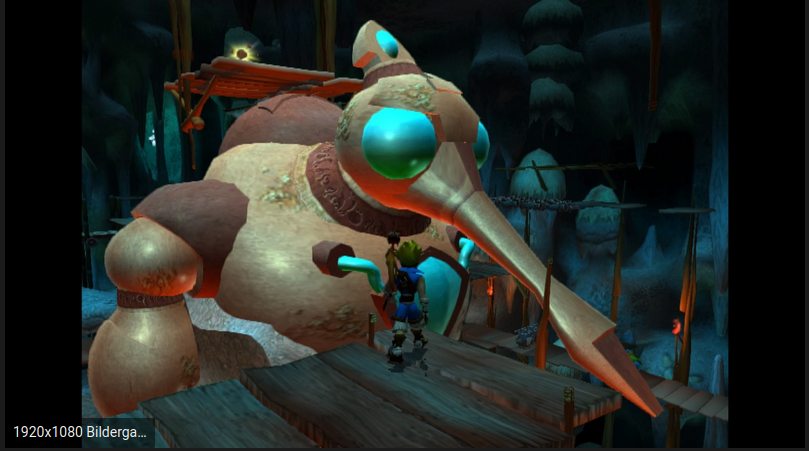
The game ends after about ten hours at most with an extremely satisfying final boss fight where Daxter gives up his chance to become human again to save the world, and it immediately continues with its sequel Jack 2.
The game is extremely short, but this is not a flaw. On the contrary, it offers a dense and extremely enjoyable experience. No level seems superfluous, nor does any resemble another. And they have all been extremely well crafted in terms of both gameplay and artistic direction. You finish the game feeling that there is nothing to add or remove.
If at the time this brevity coupled with the lack of replayability could be seen as a flaw, in the current era where games cost almost nothing and we are flooded with games, each better quality than the last (not to mention the constraints of adult life which greatly limit the time available for video games), this brevity is on the contrary one of its strengths.
Jack 2
We start with an improvement.
Already of course, with a legendary intro that marks a clear change of atmosphere in this new game, but above all, once past the title screen and the first cutscene, the game starts with a much better tutorial.
Indeed, it is partially disguised by a level of prison escape that makes sense in the story and is especially much shorter and less tedious than its equivalent in the first Jack and Daxter. And it immediately teaches us all the moves that are used in the game. At least those that can be used at the beginning of the game, as the range of actions will expand as the game progresses. For now, anyway, they are essentially the same as in Jack 1. Except for some that are rarely used, like the famous jumping punch, which have been purely and simply removed.
After this tutorial and a first mission consisting of defeating a small number of guards, we find ourselves released into the futuristic city where we landed, after passing through a precursor portal found at the end of the first game. And there, it's a shock. If at first, we thought that in terms of gameplay, this game would be similar to the first, we quickly realize that behind the appearances this game is completely different.
Where the first Jack was a 3D platform game explicitly inspired by Mario 64, this one is a GTA-like. The game is no longer organized into levels that one is free to explore in any chosen order with an optional part, but into a succession of levels that must be completed.
The success of missions is no longer rewarded with energy piles and the visual treat of Jack and Daxter's choreographies, but with cutscenes narrating the continuation of the story.
If the first 3 missions require completing a platform level, very quickly, shooting mechanics are introduced and the missions become focused on combat and vehicle driving (although the platform makes some returns as notable as they are enjoyable).
There are 3 Hubs that are successively accessible, but a big hub called Abriville that allows you to talk to different characters to get your mission.
And it's not just the gameplay that changes, the universe and atmosphere have changed considerably.
In this game, there will be practically no mention of the precursors and the lush, colorful settings of the first game, but rather the sprawling city of Abriville, which gathers what remains of humanity under the yoke of the totalitarian government of Baron Praxis, who will stop at nothing to maintain his power.and prevent an army of monsters named Metal Heads from entering the city and massacring all the inhabitants.
End the rather cheerful and relaxing (though forgettable) melodies of the first game. From now on, you will have much more striking melodies that convey a feeling of sadness and resignation, which fits well with the ghetto and industrial area where we are confined at the beginning of the game (we will later have access to agricultural areas and a futuristic business district that is a mix of Manhattan and Venice).
Finished with the light and simplistic plot that is ultimately just an excuse for the journey. From now on, you will have a complex plot and characters with multiple twists and turns.
Gone is the light-hearted atmosphere of the first games. Here, cars are stolen and guards are killed by the dozen with a machine gun (which will result in the game being banned for those under 12 in France).
The young mute child character from the first game who was enamored with adventure is gone. Jack is now a virile man driven by revenge, so the lines are filled with rage, working for the local underworld or the resistance against Baron Praxis.
The quest for the secrets of the precursors is over, here we will mostly talk about the secrets of Abriville, its legendary founder: Mar, and the struggles between the totalitarian power, the resistance, the mafia, and the metal-heads (the monsters from the beginning) who besiege the city.
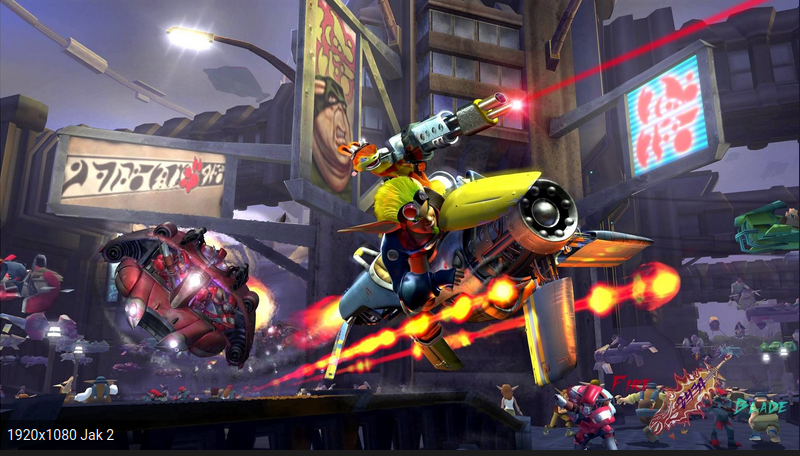
In short, apart from Daxter who keeps his appearance and character, this game is a sequel in name only.
In reality, it is more of a completely different game that doesn't even take place in the universe of the first one. One might think it's the same universe when learning midway through the game that the precursor portal sent them to the future and thus this horrible world is their future. But, it is totally inconsistent with what we are told in Jack1.
For example, in Jack1, the dark eco was a powerful but extremely dangerous substance that even the Precursors could not master. In Jack2, the dark eco is the main source of energy for Abriville, and everyone handles it as if it were a harmless substance. And the geography of its world has nothing to do with that of Jack1 (and I won't be convinced that Mar had the technology to level volcanoes). Contrary to what the cinematics say, finding a wooden building in Jack2 that resembles one of the iconic buildings from Jack1 is not proof that Abriville is the future of the world of Jack1 (not to mention that the building being made of wood would have disappeared long ago if it were indeed their future).
For me, the best explanation is that the portal took them to a world that has similarities but has nothing to do with that of the first game. There is indeed a time travel story, because the portal, when reopened at the end, leads to the past of their original world, but if we want to make the story at least somewhat coherent, we must assume that the portal allows for travel through both time and space. Moreover, one could explain the resemblance between Samos's hut in Jak 1 and 2 by assuming that upon his arrival in the past of Jak 1, young Samos built his hut based on the model of the one he had in the past and in Jak 2.
However, now that we have accepted that these are two different games and have come to terms with our disappointment at not having the continuation of kind Jack's adventures, we must ask ourselves what this game is worth on its own. Well, in summary, apart from the difficulty management, the game does excellently what it tries to do, but I don't like what it tries to do.
To start, let's talk about the major downside of this game: its difficulty.
It's not that it's excessive, but that it's very poorly managed. Indeed, despite the increase in the number and power of enemies, the difficulty decreases as the game progresses. For my part, the gain offered by acquiring new weapons and abilities for dark-Jack makes the game much easier at the end than at the beginning. But, at a pinch, that's not necessarily a flaw.
Sometimes it is even intended by the developers to give the player a sense of power and having mastered a hostile environment. The problem is that the initial difficulty is almost impossible and very frustrating, while at the end, it is just normal. And this problem is exacerbated by the fact that this time, missions must be completed in order and we do notcan no longer skip the passages that are too difficult to come back to later. It was necessary to have a better experience, but it really makes the game's difficulty frustrating. Here, there is no longer any question of adaptive difficulty. Jack is an adult, or rather, a man with imposing virility, and a man does not avoid difficulties.
But, Naughtydog not doing things by halves, they decided to add another reason to deter new players from investing in the adventure by making us start our adventure in the ugliest settings of the game (and without the shooting abilities that make this game more fun and easier). However, I think it is a deliberate choice by the developers to prioritize the atmosphere and the storyline over the pleasure of gameplay. Indeed, it would have been much more enjoyable to start in the wealthy neighborhoods with enough arsenal to defend a schoolboy in an American school, but the player would have felt much less of the sinister atmosphere of totalitarian dystopia that the game tries to convey.
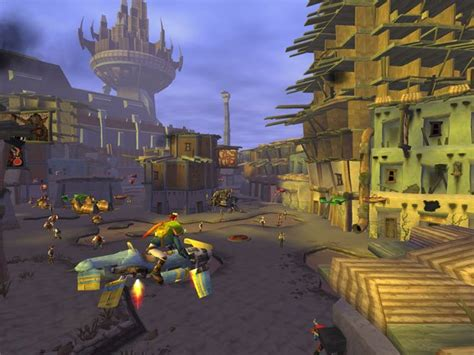
In any case, the result is a particularly off-putting game for newcomers. I remember that the first time I played this game as a child, I gave up, and the friend I lent it to never got past the third mission (where you're chased by a tank in the Grenagarde fortress). However, I persisted because I didn't have other games and also because the game has enormous qualities that couldn't be present without its flaws, such as its storyline, its gameplay which becomes excellent once the difficulty returns to a more normal level, and excellent level design that allows it to express its full potential.
Let's talk about the game's greatest strength: its storyline, which is just one of the best I've seen in a video game. Not so much because of the story itself (which, despite being full of quality, remains a fairly classic case of fighting against a totalitarian dystopia), but because of its implementation. The dialogues oscillate between brilliant and hilarious. The voice acting is of rare quality in video games of this era, and the characters are very well written (special mention for the crime lord: crew).
This labyrinthine city with well-defined districts and constantly patrolled by trigger-happy guards wonderfully conveys the sense of oppression intended by the developers, which no film or book has managed to match in my admittedly biased eyes of someone who truly discovered the concept of a totalitarian dystopia with this game. And the design of the city is so good that we understand the purpose of each district without needing an explanation. We just have to wander around the city for it to tell us something. Even today, it feels like walking through a coherent and lively world (of course, all the inhabitants are identical-looking clones, we're on PS2, I remind you). It's an achievement that many open-world games still fail to reach today, while here, we're on PS2.
The problem is that we don't take the time to admire it because our eyes are constantly fixed on our mini-map or on the obstacles.
Indeed, unlike Jack 1 where you could go wherever you wanted and always find something to do, here you have to go to the exact place where the scenario requires you to go. And, you cannot get there based on the information provided by the NPCs and the cutscenes. Firstly, because they rarely provide usable information, but also because the city is labyrinthine. While this wonderfully gives the impression that the city is immense and oppressive, it means you cannot navigate it on your own, even after several dozen hours of gameplay.
And, the downside to the fact that there are guards everywhere with a quick trigger finger, giving the impression of being in a totalitarian regime, is that at any moment, you risk accidentally bumping into one and ending up being chased. In fact, when you want to avoid being pursued (and believe me, you want to avoid it, because the missions are difficult enough without starting them with part of your life cut off), moving around the city is extremely laborious and prevents you from enjoying the scenery. But, it's necessary to have this atmosphere that fits wonderfully with the story.
On the other hand, there remain certain flaws that, in my opinion, have no justification.
For example, the transformation into dark-Jack. At first, it's just a transformation that puts all the guards on alert and you can no longer use your weapons. On the other hand, your punches are more powerful. Suffice it to say that you never want to use it and when you do transform, it's by mistake and it makes you lose the game.
Fortunately, it is rare to transform by mistake. Towards the end of the game, in the form of dark-Jack, you are invincible and can launch a super attack that kills all enemies. There, this form is useful, but it's at the end of the game, and most of the time, you'll prefer to keep your distance from enemies by using your weapons. In any case, the transformation requires so much dark eco that you can rarely do it. And this, while the cutscenes tell us that this form makes Jack super powerful and that Praxis wants to capture him to use it.
For me, it's purely a failure, probably due to the fact that the developers feared making the game too easy if they made this form too overpowered. And it's true that at the beginning of the game, dark-Jack's invincibility could have trivialized many situations (notably the famous third mission with the tank). But it would have been better than having insurmountable difficulty spikes. The dark-Jack form could even have served as adaptive difficulty by allowing bad players like me to get through the most difficult phases by farming dark eco, while good players could have done without it.
But the biggest avoidable flaw is the conduct.
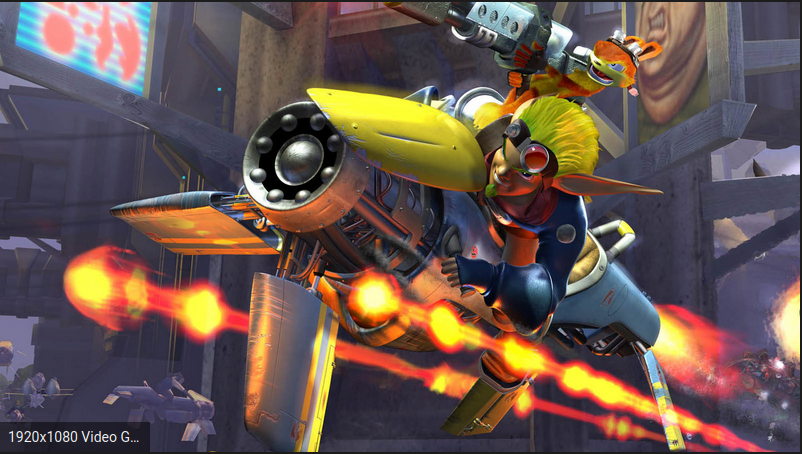
I have already briefly addressed the issue by talking about the difficulty of not accidentally knocking over a guard and thus being pursued, but the main problem with driving is that your vehicle is extremely fragile. If your vehicle crashes into another at full speed, it explodes and you end up on foot with a third of your life lost.
And if you make a mistake at a lower speed, it gets damaged, which means it will go much slower and explode at the slightest impact. You might say that this only applies to the most fragile vehicle that resembles the zoomer from the first game. However, in half of the driving missions, this vehicle is mandatory, so any impact means you lose the mission and have to start over from the beginning. And, the other vehicles are hardly more resilient. Coupled with ultra-crowded and congested streets, navigation becomes extremely laborious. And of course, this contributes to the game's difficulty.
It should be noted, however, that unlike GTA, when a mission fails, you don't have to redo a journey. You respawn right next to where you can restart the mission. Thus, the difficult navigation is not a flaw that is particularly noticeable outside of the missions. It even contributes to the dark and heavy atmosphere of Abriville, but navigation could have been made simpler/more pleasant without harming this atmosphere.
In conclusion, we have here a new game that tries to do something completely different from what the studio has done in recent years. And despite a few hiccups, it succeeds extremely well. However, its hiccups are concentrated at the beginning of the game. As a result, many players will give up early and will not see its qualities, particularly its exceptional storytelling.
Jack 3
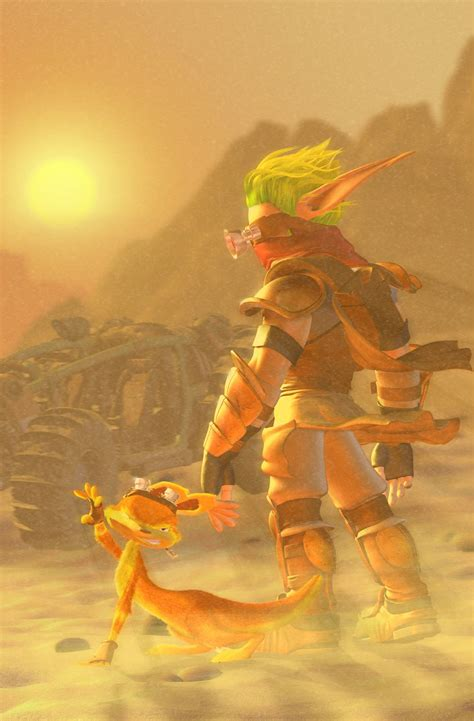
Fortunately, the game will have a sequel that will fix all its flaws. Indeed, Jack 3 will resemble Jack 2 a lot (a little too much according to some). In fact, it's simple in my opinion, Jack 3 is Jack 2 without the flaws.
In Jak 3, there is a lower difficulty (without being too low) and the most frustrating missions like escort missions have been removed or greatly simplified. The movement is extremely pleasant, starting in a city inFull desert that is extremely fun to explore and much less depressing than Abriville. And then, we wander through an Abriville in civil war where it is incredibly thrilling to fly at low altitude crushing the enemies. Moreover, the consequences of the war have made the city lose its labyrinthine character, and now you can navigate it without using the mini-map. And of course, the storyline remains excellent and once again focuses on the precursors (to my great delight).
And it is an excellent example that contrary to what online film critics say, it does not matter if a story is incoherent.
Indeed, one of the end twists about the precursors (which I will not reveal) is completely inconsistent with what we know about the precursors from the other games (and with the appearance of the black precursor in Jack3). But, what a brilliant twist it is. Without it, the story (and the game) would be much less good, and it is impossible to make it consistent with the rest of the story. However, it is presented in such a way that we accept this inconsistency.
This game shows us by example that it doesn't matter to have inconsistencies (all stories have them anyway), as long as what they bring is worthwhile and we are able to use staging to not break the suspension of disbelief.
I would add that one can also limit its inconsistencies to minor details of the plot, over which a sufficient veil of mystery hangs so that one thinks there is a logical explanation for this apparent paradox (as we do every day in real life when inconsistent information reaches us).
However, this means that apart from saying that Jack3 is great and concludes the series beautifully, I don't have much to say about it.